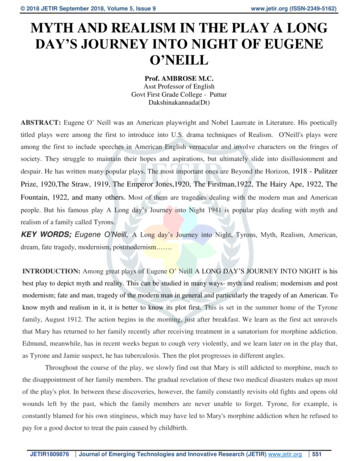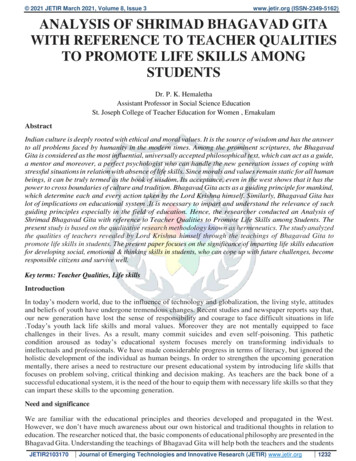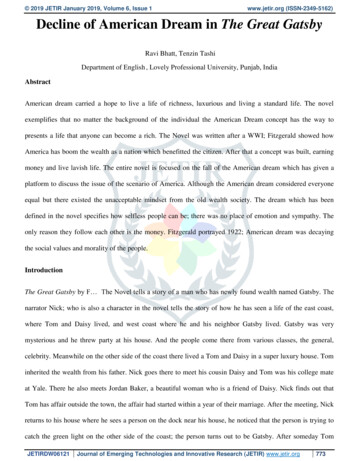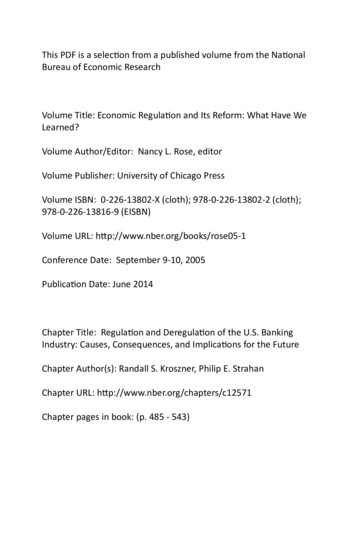
Transcription
2018 JETIR September 2018, Volume 5, Issue 9www.jetir.org (ISSN-2349-5162)MYTH AND REALISM IN THE PLAY A LONGDAY’S JOURNEY INTO NIGHT OF EUGENEO’NEILLProf. AMBROSE M.C.Asst Professor of EnglishGovt First Grade College - PutturDakshinakannada(Dt)ABSTRACT: Eugene O’ Neill was an American playwright and Nobel Laureate in Literature. His poeticallytitled plays were among the first to introduce into U.S. drama techniques of Realism. O'Neill's plays wereamong the first to include speeches in American English vernacular and involve characters on the fringes ofsociety. They struggle to maintain their hopes and aspirations, but ultimately slide into disillusionment anddespair. He has written many popular plays. The most important ones are Beyond the Horizon, 1918 - PulitzerPrize, 1920,The Straw, 1919, The Emperor Jones,1920, The Firstman,1922, The Hairy Ape, 1922, TheFountain, 1922, and many others. Most of them are tragedies dealing with the modern man and Americanpeople. But his famous play A Long day’s Journey into Night 1941 is popular play dealing with myth andrealism of a family called Tyrons.KEY WORDS; Eugene O’Neill, A Long day’s Journey into Night, Tyrons, Myth, Realism, American,dream, fate tragedy, modernism, postmodernism .INTRODUCTION: Among great plays of Eugene O’ Neill A LONG DAY’S JOURNEY INTO NIGHT is hisbest play to depict myth and reality. This can be studied in many ways- myth and realism; modernism and postmodernism; fate and man, tragedy of the modern man in general and particularly the tragedy of an American. Toknow myth and realism in it, it is better to know its plot first. This is set in the summer home of the Tyronefamily, August 1912. The action begins in the morning, just after breakfast. We learn as the first act unravelsthat Mary has returned to her family recently after receiving treatment in a sanatorium for morphine addiction.Edmund, meanwhile, has in recent weeks begun to cough very violently, and we learn later on in the play that,as Tyrone and Jamie suspect, he has tuberculosis. Then the plot progresses in different angles.Throughout the course of the play, we slowly find out that Mary is still addicted to morphine, much tothe disappointment of her family members. The gradual revelation of these two medical disasters makes up mostof the play's plot. In between these discoveries, however, the family constantly revisits old fights and opens oldwounds left by the past, which the family members are never unable to forget. Tyrone, for example, isconstantly blamed for his own stinginess, which may have led to Mary's morphine addiction when he refused topay for a good doctor to treat the pain caused by childbirth.JETIR1809876Journal of Emerging Technologies and Innovative Research (JETIR) www.jetir.org551
2018 JETIR September 2018, Volume 5, Issue 9www.jetir.org (ISSN-2349-5162)Mary, on the other hand, is never able to let go of the past or admit to the painful truth of the present, thetruth that she is addicted to morphine and her youngest son has tuberculosis. They all argue over Jamie andEdmund's failure to become successes as their father had always hoped they would become. As the day wears on,the men drink more and more, until they are on the verge of passing out in Act IV. Most of the plot of the play isrepetitious, just as the cycle of an alcoholic is repetitious.The above arguments occur numerous times throughout the four acts and five scenes. All acts are set inthe living room, and all scenes but the last occur either just before or just after a meal. Act II, Scene i is setbefore lunch; scene ii after lunch; and Act III before dinner. Each act focuses on interplay between two specificcharacters: Act I features Mary and Tyrone; Act II Tyrone and Jamie, and Edmund and Mary; Act III Mary andJamie; Act IV Tyrone and Edmund, and Edmund and Jamie.The repetitious plot also helps develop the notion that this day is not remarkable in many ways. Instead, it is onein a long string of similar days for the Tyrones, filled with bitterness, fighting, and an underlying love.It is a long evening -- four acts, beginning at 7:30 p.m., with two intermissions and a curtain call just after11. Long Day's Journey into Night did not drag for a moment, a fact that surprised me, for I had read the lengthyplay ahead of time. O'Neill maintains the unity, presses the action forward, and gives each of these actorsspeeches full of unexpected turns, with myth and reality.For example: on the written page the fourth act, whichtakes place after midnight, had seemed to be a meandering, maudlin session over a whiskey bottle and cards.Director Lucien Douglas and the cast pace the action with a see-saw, gradually gathering upward tension,making the most of the series of duo scenes. Father and younger son play cards and slowly reach beyondconfrontation; as the elder son stumbles up the walk, drunk, the father leaves the two brothers alone. Theirconversation, fueled by whiskey, is angry, then affectionate, wandering and scandalously anecdotal, then deeplydesperate.The elder brother's collapse onto the sofa brings the father in from back porch. Shortly afterward, themother comes downstairs with the distracted, otherworldly demeanor of a sleep walker and a seer. Her finalspeeches are an aria of love and regret, paying no attention to interruptions and little attention to those whom sheloves. She rises, almost visibly, toward the mystic obliteration of her drug. O'Neill was intelligent and honestenough to see beyond his father's pinch-penny, sententious exterior, however much the man may have marredhim. Ev Lunning, Jr., is a fine actor who as James Tyrone, Sr., plays a harassed, upset and bewildered formeractor. His rasp and gruffness give us with great subtlety the dilemma of every parent disappointed in himself, inhis wife, and even more in his offspring -- a good man past his effectiveness but still vigorous and uncertainwhere to turn. Patricia Pearcy as Mary Tyrone is a creature of translucent yearnings, factual aboutdisappointment but nevertheless in deep denial. Her vulnerability is haunting.Nigel O'Hearn as Edmund the consumptive plays the afflicted O'Neill with more energy than one might expectfrom a patient about to get a sentence to a sanatorium, and he is surprisingly resistant to the quantities of whiskeysloshing about. O'Hearn bears a gratifying resemblance to the author, a detail more appreciated in hindsight asJETIR1809876Journal of Emerging Technologies and Innovative Research (JETIR) www.jetir.org552
2018 JETIR September 2018, Volume 5, Issue 9www.jetir.org (ISSN-2349-5162)one comes to understand the alert, disappointed watchfulness of this character. Rachel Dendy plays the pertlycunning, garrulous second servant Cathleen. In her brash simplicity, in Act II she serves as a telling foil to heremployer Mary Tyrone, who is slipping into neurasthenia and addiction.O'Neill puts several recitations into this piece. Edmund quotes a translation of Baudelaire; he and Jamie quotelines from 19th century English poets Ernest Christopher Dowson, Oscar Wilde, Kipling, Dante Gabriel Rosetti,and, to underline the climax of the final scene, Algernon Swinburn's "Leave Taking" ("Let us go hence, mysongs; she will not hear.") To relatively less literary 21st century ears, these passages seem less apposite thanthey might have been at the play's date of 1911 or when O'Neill wrote it in 1941. The Dowson verses, inparticular, seem to have survived principally in lyrics in mid-century popular songs ("the days of wine androses" and " . . . I have always been faithful to thee . . . in my fashion.In contrast, many of the monologues for his characters are gripping. Again, examples from the fourth act: stungby Edmund's reproach for his miserliness, Lunning as James Tyrone in his drink recounts his origins and hisacting career with a frankness and eloquence that belies the alcohol. Edmund responds with "high spots" from hismemories of the sea. O'Hearn's delivery of these is curiously detached, perhaps intentionally, since Edmundresponds derisively to his father's comment,David Gallagher in the role of the debauched elder brother Jamie is fire and bitterness. One understands that he isnot primarily an alcoholic; rather, caught between his anger at his well-meaning father and his contempt forhimself, he is addicted to self-destruction. Gallagher is in precise control of a character who otherwise couldeasily slip into maudlin self-pity. He gives Jamie a snarling frankness, touched intermittently with ineffectualattempts at expressing affection for his younger brother. These deeply conflicted attitudes rise to a climax in theirduo scene in Act IV. Jamie, swilling whiskey in an effort to shut himself down, fiercely warns Edmund, "I'd liketo see you become the greatest success in the world. But you'd better be on your guard. Because I'll do mydamnedest to make you fail. Can't help it. I hate myself. Got to take revenge. On everyone else. Especially you."That's a scene written 30 years later by a deeply unhappy, enormously gifted dramatist. A man in failing healthwho had been writing all his life to escape that ugly house in New London and the torment of memory.In Long Day’s Journey into Night, O’Neill fuses the present and the past and the influence of the past on thepresent pervades the work from the beginning to the end. If O’Neill was able to transform classical myth intomodern secular tragedy with Desire Under the Elms, he was to achieve even more success with Long Day’sJourney into Night. Through tools like the fog in Long Day’s Journey, which represents inner states of mind, hewas able to substitute some of the mythical “otherness” of “fate” found in classical tragedy. This fog hasuncanny similarities to the rain the falls persistently through the action of Shepard’s Buried Child, cutting offanother American family from the outside world. Another way of expressing the “otherness” of fate is expressedthrough verbal repetition. The usage of mind-altering substances also permeates Long Day’s Journey as alcoholand morphine cause the characters to lose control of themselves and perhaps speak too much. O’Neill conceived“classic fate” as “family fate.” In Long Day’s Journey into Night, time becomes a crucial theme. The title itself isJETIR1809876Journal of Emerging Technologies and Innovative Research (JETIR) www.jetir.org553
2018 JETIR September 2018, Volume 5, Issue 9www.jetir.org (ISSN-2349-5162)the first indication of the importance of time in the play as it traces an inexorable descent into darkness. In thissense, O’Neill’s play is clearly part of the continuum of the theme of lost American innocence. Their dilemmaand that of the culture at large stems from being in time and longing for an ideal which is not. In Long Day’sJourney to Night, he decided to repeat the same theme on a more intimate level by focusing on the individualwithin a smaller unit and a single generation, and this, of 199 main differences regarding how this drama differsfrom that written by modern dramatists. There are few (if any) referents to hold onto. Gone are the sureties oftime, place and identity of the older dramatists.There appears to be little past and the future portends little more. Tragicomedy seems to have robbeddramatic realism of individuality in opposition to social constraints, which, as mentioned before, werediscernable by the spectator. Formerly, the spectator used to be able to grasp the exact notion of the moraldilemma. Even in O’Neill’s Desire under the Elms, it is clear that everyone desires something whether what isdesired is attainable or not. Fate is still very present in these plays as well. If fate of one sort or another hoversover all of tragedy, then tragicomedy is no different. There is still an external force, an external “something” thatdetermines human action, but it has no public face, no visible manifestation. This might also point to one of themain differences between Modernism and Postmodernism. Modernism has grounding, in this case the father asan authoritative figure. To my mind, O’Neill will be remembered for his late plays in which he was able torecreate the private and the personal while portraying the ravages of hereditary guilt. In Long Day’s Journey intoNight, the Tyrone family past has been broken up into fragments but these fragments make up a whole that theviewer or reader is able to grasp. Life is no longer knowable and character dissolves into a type of psychicbattlefield and insoluble puzzle. Long Day’s Journey into Night fits into this pattern quite easily andcomfortably. It is a play where character is a psychic battlefield, beliefs in the past are discovered to be sham,human existence cannot be transformed, being a hero is nigh on impossible and borders on the absurd, life isunknowable, becoming more a series of sensations, albeit blunted by mind-altering drugs, than anything linear.CONLUSION: Perhaps one of the better ways to begin to divulge modernist techniques at work in Long Day’sJourney into Night is to consider the notion of time. In many ways, it can be considered a play about the sense ofloss produced by the ravages of time. Throughout the play there is an amalgam of myth and realism. Thisproduction of Long Day's Journey into Night is a remarkable gift to anyone who loves serious drama. If you fallinto that category, you have only four opportunities left to see it. It is an effort to find myth and realism in theplay I would have told you earlier, but this production just knocked me over. It took a while to digest it so that Icould recommend it appropriately to talk more about myth and realismJETIR1809876Journal of Emerging Technologies and Innovative Research (JETIR) www.jetir.org554
2018 JETIR September 2018, Volume 5, Issue 9www.jetir.org (ISSN-2349-5162)NOTES AND REFENCES:2Louis Sheaffer, O'Neill: Son and Artist (Boston: Little, Brown and Company, 1973),3John Henry Raleigh, The Plays of Eugene O'Neill (Carbondale & Edwardsville: Southern Illinois UniversityPress, 19654Jean Chothia, Forging a Language: A Study of the Plays of Eugene O'Neill (Cambridge: Cambridge UniversityPress, 1979), p. 166.5Frederic Carpenter, Eugene O'Neill (Boston: Twayne Publishers, 1979)6Robert F. Whitman, "O'Neill's Search for a 'Language of the Theatre,'" in O'Neill: A Collection of CriticalEssays, ed. John Gassner (Englewood Cliffs, N.J.: Prentice-Hall, Inc., 1964).7James Tyrone frequently refers to morphine as "poison": "It's the damned poison" (p. 174); "Up to take more ofthat God-damned poison, is that it?" .8Eugene O'Neill, Long Day's Journey Into Night (New Haven: Yale University Press, 1956),JETIR1809876Journal of Emerging Technologies and Innovative Research (JETIR) www.jetir.org555
In Long Day's Journey into Night, O'Neill fuses the present and the past and the influence of the past on the present pervades the work from the beginning to the end. If O'Neill was able to transform classical myth into modern secular tragedy with Desire Under the Elms, he was to achieve even more success with Long Day's Journey into Night.










